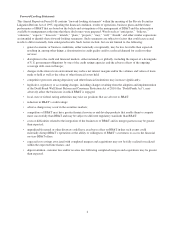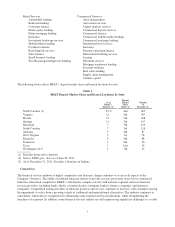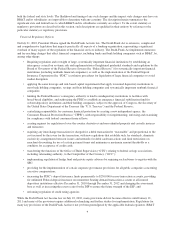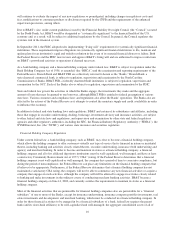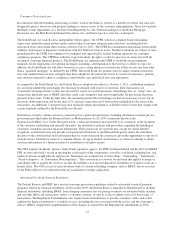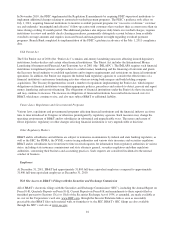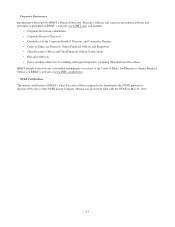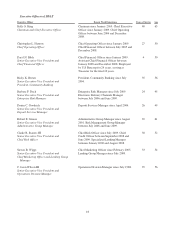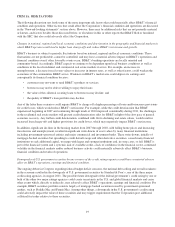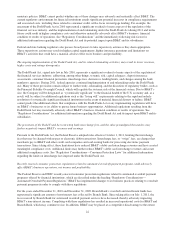BB&T 2011 Annual Report Download - page 12
Download and view the complete annual report
Please find page 12 of the 2011 BB&T annual report below. You can navigate through the pages in the report by either clicking on the pages listed below, or by using the keyword search tool below to find specific information within the annual report.insolvent or is in danger of becoming insolvent. For example, under requirements of the Federal Reserve with respect to
bank holding company operations, a bank holding company is required to serve as a source of financial strength to its
subsidiary depository institutions and to commit financial resources to support such institutions in circumstances where it
might not do so otherwise. In addition, the “cross-guarantee” provisions of federal law require insured depository
institutions under common control to reimburse the FDIC for any loss suffered or reasonably anticipated by the DIF as a
result of the insolvency of commonly controlled insured depository institutions or for any assistance provided by the
FDIC to commonly controlled insured depository institutions in danger of failure. The FDIC may decline to enforce the
cross-guarantee provision if it determines that a waiver is in the best interests of the DIF. The FDIC’s claim for
reimbursement under the cross-guarantee provisions is superior to claims of shareholders of the insured depository
institution or its holding company but is subordinate to claims of depositors, secured creditors and nonaffiliated holders of
subordinated debt of the commonly controlled insured depository institution.
Federal and state banking regulators also have broad enforcement powers over the Banks, including the power to impose
fines and other civil and criminal penalties, and to appoint a conservator (with the approval of the Governor in the case of
a North Carolina state bank) in order to conserve the assets of any such institution for the benefit of depositors and other
creditors. The North Carolina Commissioner of Banks also has the authority to take possession of a North Carolina state
bank in certain circumstances, including, among other things, when it appears that such bank has violated its charter or
any applicable laws, is conducting its business in an unauthorized or unsafe manner, is in an unsafe or unsound condition
to transact its business or has an impairment of its capital stock.
Payment of Dividends; Capital Requirements
BB&T Corporation is a legal entity separate and distinct from the Banks and its subsidiaries. The majority of BB&T’s
revenue is from dividends paid to BB&T by Branch Bank. The Banks are subject to laws and regulations that limit the
amount of dividends they can pay. In addition, BB&T and the Banks are subject to various regulatory restrictions relating
to the payment of dividends, including requirements to maintain capital at or above regulatory minimums, and to remain
“well-capitalized” under the prompt corrective action regulations summarized elsewhere in this section. Federal banking
regulators have indicated that banking organizations should generally pay dividends only if (1) the organization’s net
income available to common shareholders over the past year has been sufficient to fully fund the dividends and (2) the
prospective rate of earnings retention appears consistent with the organization’s capital needs, asset quality and overall
financial condition. In November 2010, the Federal Reserve released additional guidance re-emphasizing the Federal
Reserve’s expectations concerning the processes that firms that participated in the Supervisory Capital Assessment
Program (“SCAP”), like BB&T, should have in place to ensure that they hold adequate capital under adverse conditions to
maintain ready access to funding. Any request by a bank holding company subject to SCAP, such as BB&T, to increase
dividends on common stock, reinstate or increase repurchase programs or make other capital distributions will be
evaluated based on the Federal Reserve’s assessment of capital adequacy.
In November 2011, the Federal Reserve issued a final rule requiring bank holding companies with $50 billion or more in
total consolidated assets, including BB&T, to submit annual capital plans based on pre-defined stress scenarios and to
obtain regulatory approval before making capital distributions, including dividend payments and purchasing capital
securities. This review is known as the Comprehensive Capital Analysis and Review (“CCAR”). The regulatory process
includes management’s proposals to undertake capital actions in 2012 under various economic scenarios, such as
increasing dividend payments or issuing or repurchasing common or preferred securities. BB&T submitted its first such
plan in advance of the January 9, 2012 deadline. BB&T’s 2012 capital actions will depend on the results of the CCAR
process.
North Carolina law states that, subject to certain capital requirements, the board of directors of a bank chartered under the
laws of North Carolina may declare a dividend of as much of that bank’s undivided profits as the directors deem
appropriate.
Each of the federal banking agencies, including the Federal Reserve, the FDIC and the OCC, has issued substantially
similar risk-based and leverage capital guidelines applicable to banking organizations they supervise, including bank
holding companies and banks. Under the risk-based capital requirements, BB&T and the Banks are each generally
required to maintain a minimum ratio of total capital to risk-weighted assets (including certain off-balance sheet activities,
such as standby letters of credit) of 8%. At least half of the total capital must be composed of common shareholders’
equity excluding the over- or underfunded status of postretirement benefit obligations, unrealized gains or losses on debt
12




